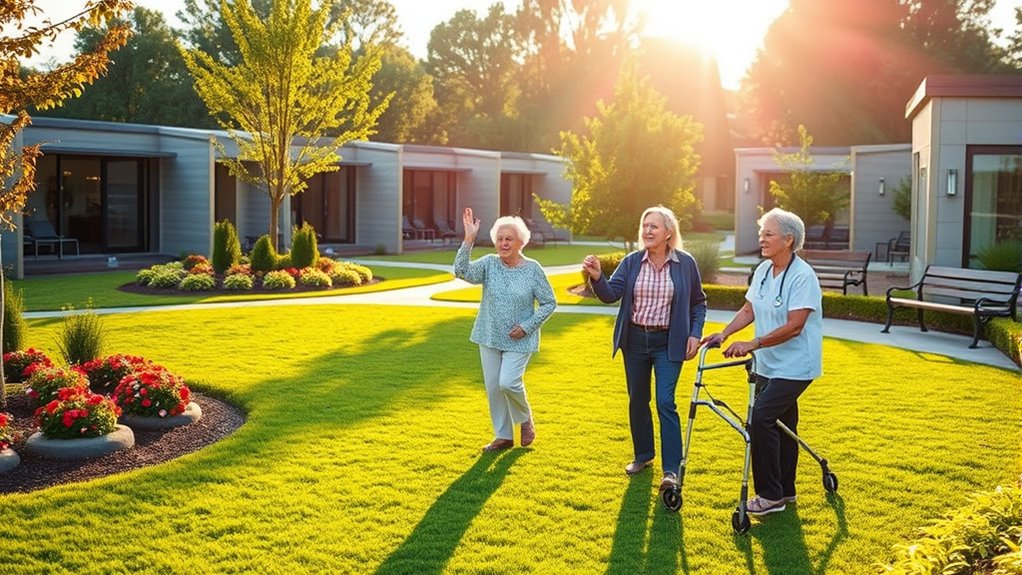As the aging population grows, you need to rethink elder care models to meet diverse needs more effectively. Traditional approaches often feel impersonal, rigid, or outdated, making it hard to balance independence and emotional well-being. Innovating with person-centered care, technology, and community-based support can improve quality of life. By adapting to demographic shifts, you’ll find new ways to serve elders better; explore how these changes can shape future care options.
Key Takeaways
- Demographic shifts demand culturally competent, personalized elder care models to meet diverse needs and improve quality of life.
- Traditional institutional care often lacks flexibility, prompting a shift toward community-based and home-centered approaches.
- Integrating technology like telemedicine, wearables, and smart home devices enhances safety, independence, and proactive health management.
- Person-centered care prioritizes individual preferences, promoting dignity, autonomy, and emotional well-being for aging populations.
- Policy reforms, workforce development, and innovative housing solutions are essential to sustainably address future elder care demands.
Demographic Shifts and Their Impact on Elder Care

Over the next few decades, demographic shifts will substantially reshape the landscape of elder care. As populations age globally, you’ll see a rise in diverse communities requiring culturally competent services. Intergenerational programs will become essential, fostering connections between young and old, promoting mutual understanding and reducing ageism. These initiatives help bridge cultural gaps, ensuring elders receive personalized, respectful care that honors their backgrounds. Incorporating Cultural Intelligence into elder care strategies will be vital to effectively address these evolving needs. You’ll need to adapt care models to meet the needs of an increasingly diverse elderly population. Emphasizing cultural competency will improve communication, trust, and overall quality of life for seniors. Preparing for these changes means integrating intergenerational programs into your strategies, making elder care more inclusive, engaging, and responsive to the evolving demographic landscape.
Limitations of Traditional Elder Care Approaches

Traditional elder care often relies on institutions that can feel impersonal and restrictive. You might find limited options for customizing care to fit individual needs and preferences. These shortcomings highlight the need for more flexible and personalized approaches.
Institutional Care Challenges
Have you ever wondered why some elderly individuals feel isolated or dissatisfied with institutional care? Traditional models often lack the warmth and personalization needed for meaningful living. These settings can be sterile, disconnected from family and community. They also face challenges like limited space for intergenerational housing, which could foster stronger bonds and reduce loneliness. Additionally, many facilities struggle with outdated infrastructure that isn’t eco friendly, increasing costs and environmental impact. This approach can make residents feel like they’re simply being cared for rather than truly supported. The rigid routines and impersonal environments fail to address emotional and social needs, leaving many feeling overlooked. These are core limitations that highlight the need for innovative, more inclusive elder care solutions.
Limited Personalization Options
Many elder care settings struggle to offer personalized experiences because they often follow a one-size-fits-all approach. Personalization barriers prevent tailored care plans that meet individual needs, preferences, and cultural backgrounds. These customization limitations make it difficult to adapt routines, activities, or communication styles, leaving residents feeling overlooked or undervalued. Staff may lack the resources or training to create flexible, resident-centered solutions. As a result, seniors miss out on meaningful engagement and independence. This rigid structure can negatively impact their mental and emotional well-being. To truly improve elder care, providers must recognize these barriers and develop innovative, adaptable models that prioritize personalized attention, ensuring each person receives care that respects their unique identity and life experience. Incorporating flexible, resident-centered solutions into care models can help overcome these challenges and foster a more supportive environment.
Person-Centered Care: Putting Residents First
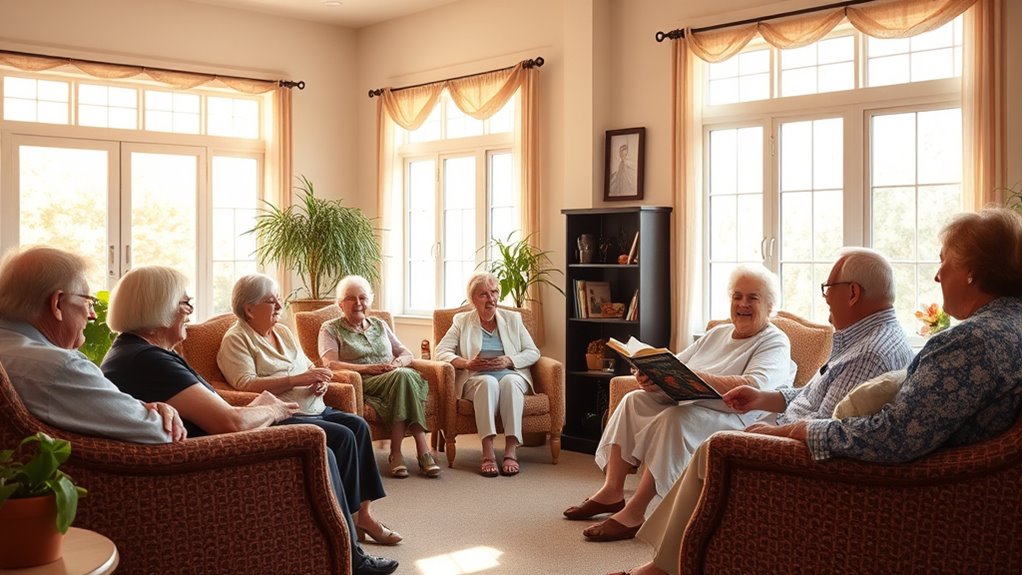
Person-centered care shifts the focus from routines and tasks to the individual needs and preferences of residents. You prioritize their choices, fostering a sense of independence and dignity. This approach encourages creating community spaces that support intergenerational housing, blending different age groups to promote engagement and socialization. When residents are at the center of decision-making, opportunities for elder entrepreneurship flourish, allowing seniors to pursue passions or small businesses that reflect their interests. By tailoring care plans to each person’s unique lifestyle, you help build a supportive environment that values their identity. This approach not only enhances quality of life but also empowers residents to remain active, connected, and respected members of the community.
Technology-Driven Solutions for Aging Populations
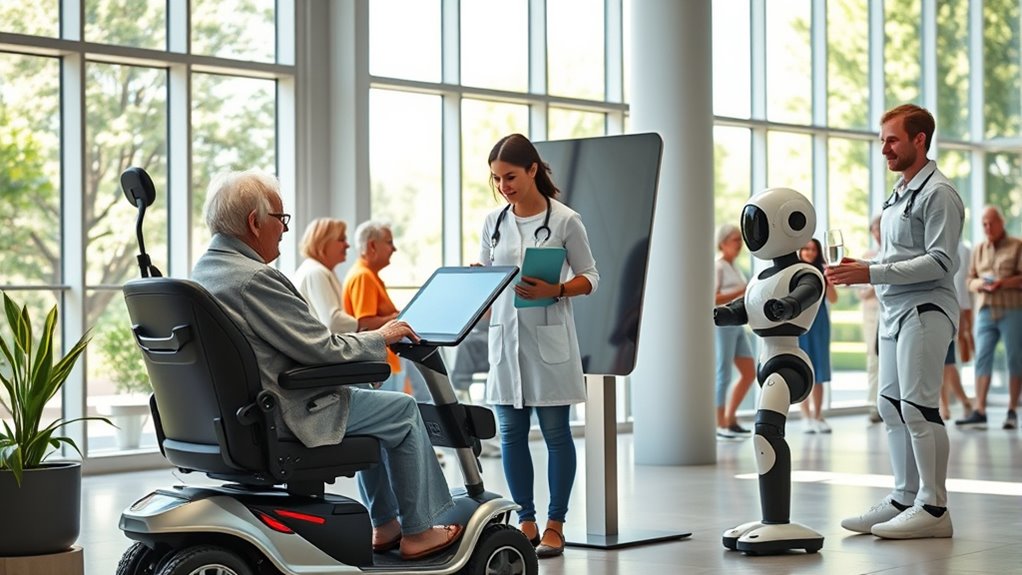
Technology plays an increasingly crucial role in enhancing the quality of life for aging populations. Wearable devices help you monitor vital signs, track activity levels, and detect health issues early, enabling proactive care. These devices can alert you or caregivers to emergencies, increasing safety and independence. Virtual companionship offers social interaction and emotional support, reducing feelings of loneliness and isolation. Through video calls or AI-powered chatbots, you can stay connected with loved ones or receive friendly engagement anytime. These technologies make daily routines more manageable and promote well-being without replacing human contact but supplementing it. Color accuracy in displays ensures clearer and more comfortable visuals during extended usage, making the experience more enjoyable. As you adopt wearable devices and virtual companionship tools, you gain greater autonomy and peace of mind, ensuring your needs are met with innovative solutions tailored for aging populations.
The Rise of Community-Based Support Systems
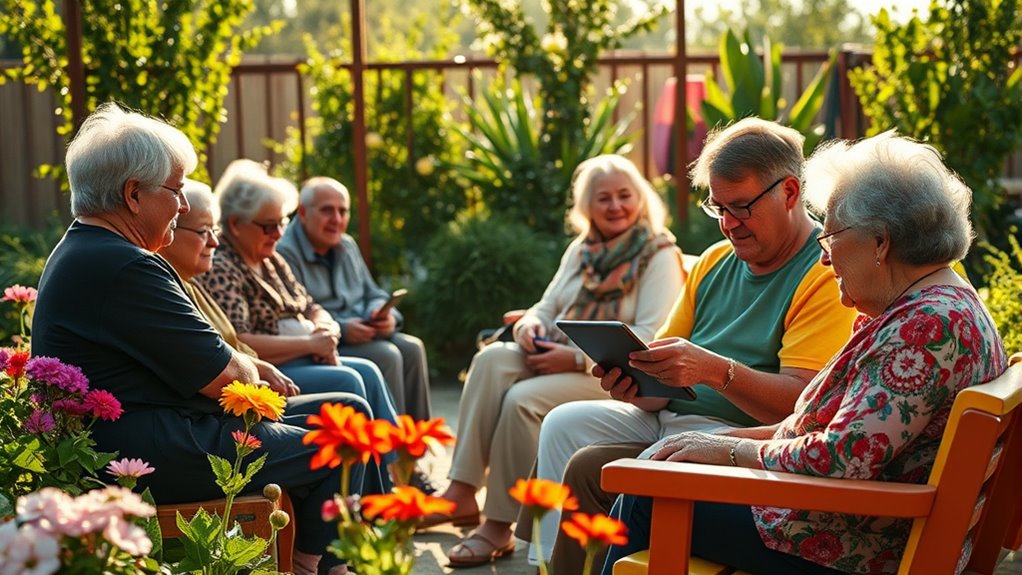
Community-based support systems are transforming elder care by connecting seniors with local volunteer networks, making assistance more accessible. These programs also improve access to integrated healthcare and create opportunities for social engagement. Together, they foster a sense of belonging and independence for older adults in their communities. Additionally, personalized in-home care enhances these efforts by addressing individual needs and promoting dignity.
Local Volunteer Networks
Have you noticed how local volunteer networks are transforming elder care? These community-based systems foster greater community engagement and improve volunteer coordination, making support more accessible. By organizing neighborhood volunteers, seniors receive companionship, errands assistance, and basic health checks. This approach not only strengthens local bonds but also reduces strain on formal healthcare services. Regular volunteer interactions can also contribute to improved skin health, as social engagement is linked to overall well-being. Below is a quick overview of common volunteer roles:
| Role | Description |
|---|---|
| Companion | Offers social interaction and company |
| Care Support | Assists with daily tasks and errands |
| Health Monitors | Checks essential signs and health updates |
Integrated Healthcare Access
Building on the strong foundation of local volunteer networks, integrated healthcare access connects seniors more directly with extensive medical services. Telehealth integration allows you to consult with healthcare providers from home, reducing the need for travel and ensuring timely care. This technology helps monitor chronic conditions and address health concerns promptly. Additionally, community-based systems now emphasize nutritional planning, ensuring you receive tailored meal guidance to support your health and well-being. These coordinated efforts make it easier for you to access thorough care without steering through complex systems alone. By combining telehealth and nutritional support, communities create a seamless network that keeps you healthier, more independent, and engaged in your daily life. This approach transforms elder care into a proactive, accessible, and personalized experience. Regular air purifier maintenance ensures a healthier environment, reducing airborne pollutants and allergens that can affect overall well-being.
Social Engagement Opportunities
How can social engagement enhance your quality of life as you age? Engaging in community-based support systems keeps you connected, active, and mentally sharp. Intergenerational activities bring different age groups together, fostering mutual understanding and shared experiences. Participating in these events helps combat loneliness and creates a sense of belonging. Peer mentorship offers you the chance to both learn from and guide others, strengthening your skills and confidence. These opportunities encourage meaningful interactions, making daily life more fulfilling. Community centers, volunteer programs, and local clubs are excellent venues to find social engagement options tailored to your interests. Incorporating effective blemish treatment with supportive social activities can further boost your confidence and overall well-being. Embracing these activities not only enriches your social life but also supports your overall well-being, helping you age gracefully with purpose and connection.
Innovative Housing Models for Older Adults

Innovative housing models are transforming the way older adults live by offering more flexible, supportive, and community-centered options. You can now choose sustainable housing that emphasizes eco-friendly materials and energy efficiency, reducing environmental impact and lowering costs. Modular design plays a key role in these developments, allowing you to customize your living space easily, adapt as your needs change, and even expand or reconfigure your home without major renovations. These models foster independence while promoting social interaction, creating a sense of belonging within the community. By prioritizing sustainability and flexibility, these housing options help you maintain a higher quality of life, ensuring comfort, safety, and environmental responsibility in your later years. Additionally, understanding signs of spoilage in perishable foods can contribute to healthier living environments and food safety, supporting overall well-being in aging populations.
Policy Changes and Funding Strategies
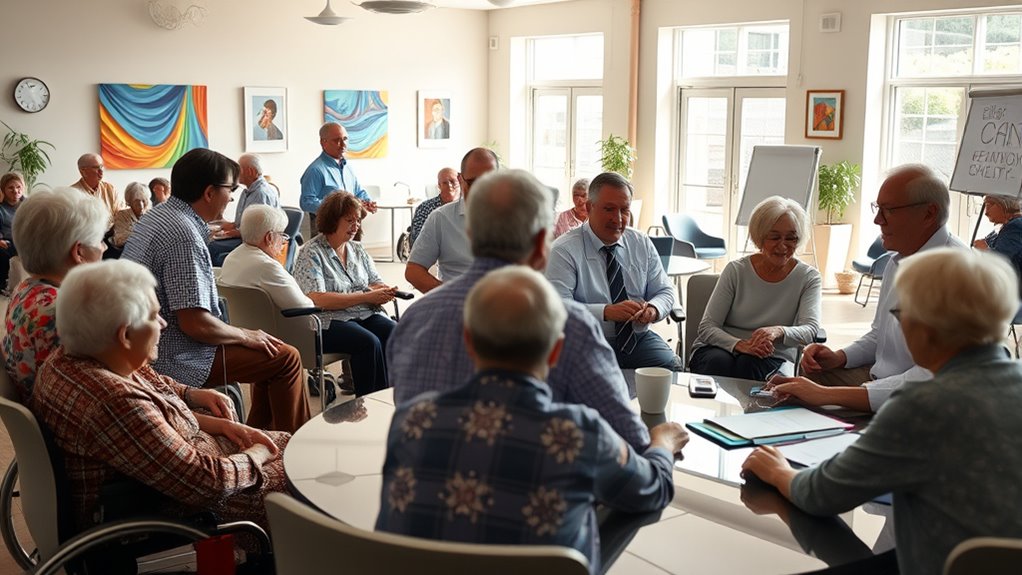
You can influence how funding is allocated to maximize resources for elder care programs. Aligning policy incentives encourages providers to prioritize quality and accessibility. By understanding these strategies, you help shape a more effective and sustainable elder care system. Implementing performance metrics can also aid in monitoring and improving care quality over time.
Funding Allocation Strategies
Effective funding allocation strategies are essential for ensuring sustainable elder care models. With budget constraints looming, you must focus on resource prioritization to maximize impact. To do this effectively, consider approaches such as:
- Redirecting funds toward high-need services
- Implementing outcome-based funding models
- Encouraging public-private partnerships for shared costs
Prioritizing resources ensures that limited funds target the most critical areas, like home-based care or mental health services. By carefully allocating budgets, you reduce waste and improve service quality. Flexibility in funding allows you to adapt to changing demographics and emerging needs. Ultimately, strategic resource management helps create resilient, efficient elder care systems that serve aging populations without overextending financial capacities.
Policy Incentive Alignments
Aligning policy incentives with funding strategies is essential for creating a cohesive elder care system. When you implement effective regulatory reforms and tie financial incentives to quality outcomes, you encourage providers to prioritize patient-centered care. This alignment reduces fragmentation and promotes efficiency. For example, policies that reward positive health outcomes motivate providers to innovate care delivery. Funding strategies can include grants or bonuses linked to performance metrics, ensuring resources support desired reforms. Here’s a clear overview:
| Policy Changes | Funding Strategies |
|---|---|
| Regulatory reforms for quality | Financial incentives for outcomes |
| Incentives for innovation | Performance-based funding |
| Simplified licensing | Grants for new models |
| Care coordination mandates | Bonus payments for collaboration |
| Transparency requirements | Funding tied to patient satisfaction |
Training and Workforce Development in Elder Care

How can we guarantee that elder care workers are prepared to meet the growing demand for quality services? Investing in thorough caregiver training is essential. Well-trained staff improve service quality and boost workforce retention, reducing turnover. To strengthen workforce development, focus on:
Investing in caregiver training ensures quality services and staff retention in elder care.
- Providing ongoing education and skill updates
- Offering competitive wages and benefits to retain staff
- Creating clear career advancement pathways
Family and Caregiver Roles in a Changing Landscape

As the landscape of elder care evolves, families and informal caregivers play an increasingly essential role in supporting seniors’ well-being. Your family dynamics may shift as responsibilities grow, often leading to caregiver burnout if support systems aren’t in place. Recognizing these challenges helps you balance caregiving duties with your own needs.
| Family Dynamics | Caregiver Burnout |
|---|---|
| Adapt to changing roles | Manage stress effectively |
| Communicate openly | Seek external help |
| Share responsibilities | Prioritize self-care |
Understanding these elements empowers you to navigate caregiving more sustainably, ensuring seniors receive proper support while safeguarding your well-being.
Envisioning the Future of Elder Support Services

The future of elder support services is poised for transformation, driven by advancements in technology, shifting demographics, and a growing emphasis on personalized care. You’ll see innovative solutions like intergenerational housing, where seniors and younger generations live together, fostering community and mutual support. Elder entrepreneurship will also thrive, empowering seniors to start businesses that match their passions and skills, promoting independence and purpose.
Key developments include:
Key developments shaping the future of elder care include innovative housing, entrepreneurship, and smart technologies.
- Intergenerational housing creating vibrant, supportive communities
- Elder entrepreneurship encouraging seniors to remain active and engaged
- Smart technologies enhancing safety, health monitoring, and daily assistance
These approaches will reshape elder care, making it more adaptable, inclusive, and person-centered, ensuring older adults live fulfilling, connected lives in the future.
Frequently Asked Questions
How Can Cultural Differences Influence Elder Care Preferences?
Cultural differences greatly influence elder care preferences. You might find that cultural norms shape how families approach caregiving, preferring in-home support or community-based services over institutional care. Caregiving traditions, such as respecting elders or involving extended family, guide decisions on care options. Recognizing these cultural norms helps you tailor elder care models to meet diverse needs, ensuring respect and comfort for seniors from varied backgrounds.
What Are the Economic Implications of Aging Populations Globally?
Imagine a tidal wave of aging populations swelling across the globe, crashing into economies. You’ll face a growing economic burden as healthcare costs soar and pension systems strain. Workforce challenges intensify as fewer young workers support more seniors, turning economies into delicate balancing acts. You must adapt policies to manage these shifts, or risk being overwhelmed by the financial currents of an aging world.
How Can Elder Care Be Made More Accessible in Rural Areas?
You can enhance elder care accessibility in rural areas by expanding telehealth services, allowing seniors to consult healthcare providers from home. Additionally, investing in community transportation ensures seniors can reach clinics or social activities easily. Combining these approaches helps bridge the gap in healthcare access, making elder care more inclusive and efficient, especially where traditional facilities are scarce. This way, rural seniors receive the support they need without unnecessary travel.
What Role Do Private Sector Innovations Play in Elder Support?
Private sector innovations play a crucial role in elder support by integrating technology and fostering community engagement. You can benefit from new telehealth services, smart home devices, and mobile health apps that make care more accessible and personalized. These innovations encourage community involvement, creating support networks that keep elders connected and cared for. By leveraging private sector efforts, you gain more convenient, tech-driven, and community-oriented elder care options.
How Can Intergenerational Programs Benefit Aging Communities?
Did you know that intergenerational programs boost community engagement by 30%? By participating in intergenerational housing, you foster stronger bonds and shared experiences across ages. These programs provide mutual benefits: younger generations gain wisdom, while older adults enjoy social connection and purpose. You help create vibrant, inclusive communities where everyone feels valued, making aging communities more resilient and connected.
Conclusion
As you navigate the evolving landscape of elder care, think of it as tending a delicate garden. Each change—technology, community support, policy—acts as nourishing sunlight or water, helping it flourish. By embracing innovative, person-centered approaches and fostering collaboration, you become the gardener shaping a vibrant, resilient future for aging populations. Together, you can cultivate a caring environment where elders thrive, ensuring their golden years shine with dignity and support.
